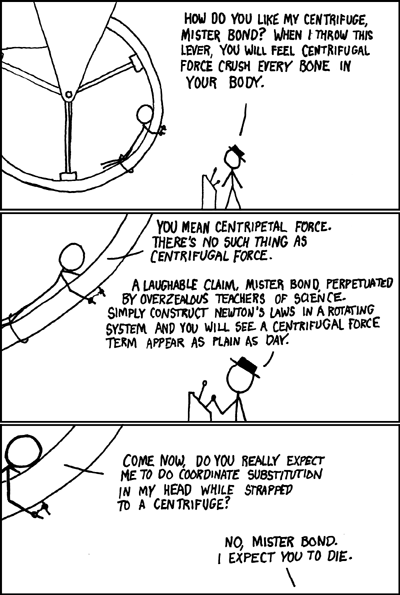I reckon most of the confusion comes down to one person in the discussion speaking (or writing) colloquially, while the other is using the more strictly defined & 'more correct' language of physics.
If you ask me my weight I'll happily reply that I weigh 83 kg.
This is, 'of course' ,
wrong.
I do NOT weigh 83 kg... my mass is 83 kg, whereas my weight is about 813 N (when not moving around on the planet Earth ;-) ... in other words when my mass is accelerated upon by Earth's gravitational field ). If I jump up and down on some bathroom scales I can see my
weight changing due to acceleration effects I am exerting on my body.
Of course... if you ask a Nobel prize winning Physicist in a bar how much he weighs... they're not going to answer in the proper scientific units because they'll sound like a weirdo

So... the stone whirling around in a circle on the end of a piece of string is continuously accelerating - and centripetal force along the string towards your finger (the centre of rotation) keeps it going round in that circle. Cut the string, and the object will move off at a tangent to the arc it was travelling on when you cut it as it no longer has the string to exert that centripetal force and provide the necessary acceleration...
which bings up confusion between speed and velocity and acceleration... again due to colloquial English vs Sciencey speak.
We 'normally' (colloquially) think of say a car accelerating when its speed is increasing... and kind of forget that what we are really dealing with is
velocity and acceleration, and that velocity takes account of both direction and speed.
What this means is that any time your
direction is changing your velocity changes... so anything ( a rock on the end of a piece of string being spun in a circle
, a car going round a corner, a skier making as turn ) is
accelerating (even though our speed may be constant.. our velocity isn't).
So a skier making a turn (or a driver taking a sharp left hand corner at speed, sitting in supportive Recaro seats) will feel that centripetal force being exerted on themselves - there is no centrifugal force to 'throw' you into the trees... there's just the risk of loss of centripetal accleration due to dodgy tyres or badly tuned ski edges and/or bad technique

Disclosure - I am not a Physicist.
ps having brought up mass and weight thanks to gravity... here's an 'amusing' misconception to wrap your head around...
"Einstein showed through the use of complex mathematics that gravity is not a force per se, but a consequence of the
curvature of spacetime. Einstein discovered that massive objects bend the spacetime around it, and we perceive of this bending of spacetime as a force."
Say what now?

Scroll down to #8 of this link for the rest
https://futurism.com/moon-will-turned-giant-particle-detector
